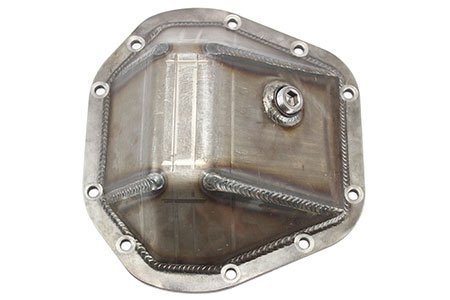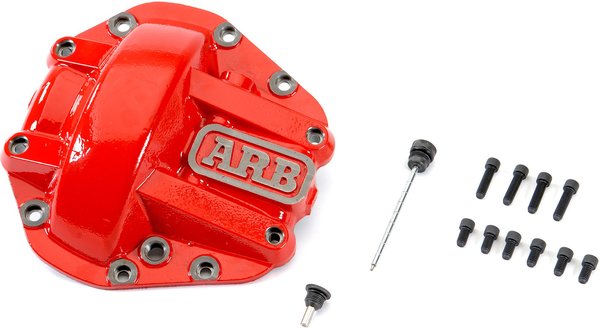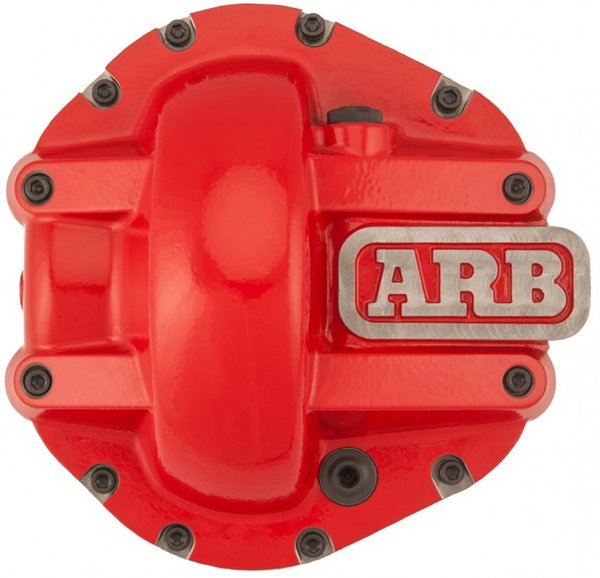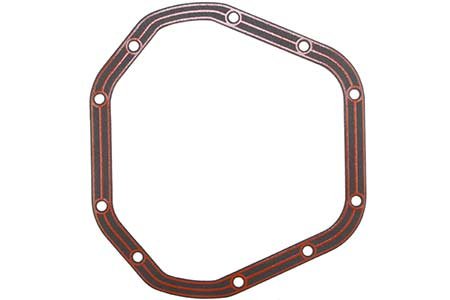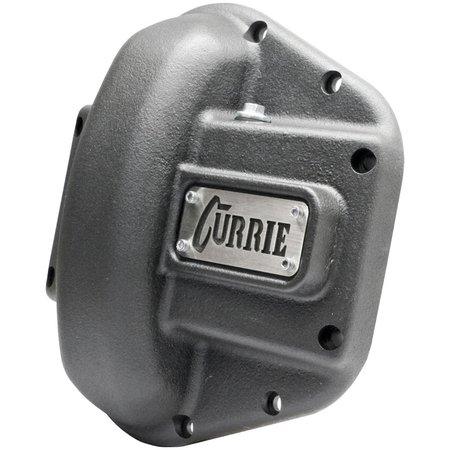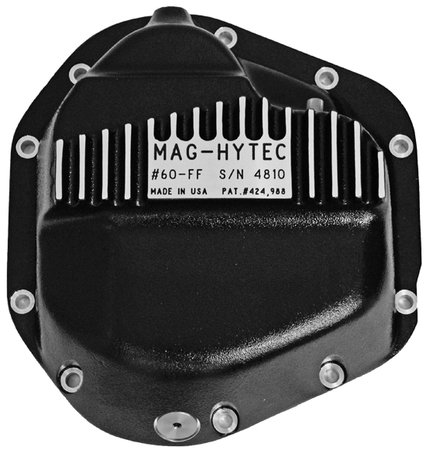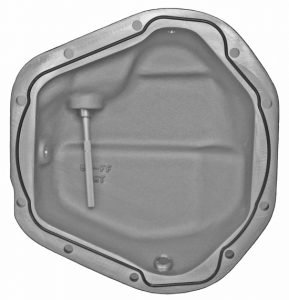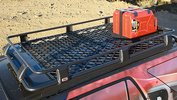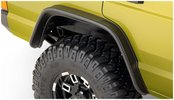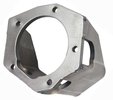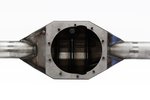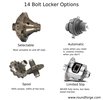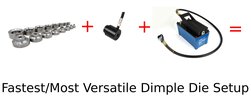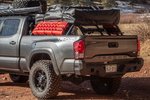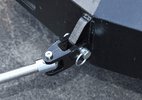Dana 60 Diff Covers for Hard Use
It seems like everyone is selling Dana 60 diff covers now. It's no surprise - 60s are an easy way to get frontend strength.
But:
That stock stamped steel diff cover ain't the strongest thing. It's easy to bend it and ding it, mash it into your ring gear, or even puncture it on the the right rock.
So we'll take a look at the components of a good diff cover and show you a few that we like. As with everything, the diff cover you choose will depend somewhat on how you use your rig.
For serious wheelers, this is probably the perfect diff cover. It's 3/8" thick, weldable, smooth, welded inside and out, and has no drain hole. Simple and strong.
If you've been wheeling long enough, you've broken front axle parts. Most of us that do this on a regular basis throw in the towel and go to a Dana 60 front and a 14 bolt rear.
A stock Dana 60 will get you pretty far, but you'll eventually want to armor it up. It's pretty lame to leak gear oil on the trail or be grinding your carrier against the stamped steel stock 60 diff cover.
So:
We're going to take a look at how some of the different Dana 60 diff covers are made so that you can pick the best one for your rig.
Dana 60 Diff Covers - WHAT TO LOOK FOR
Materials
Steel
Clearly, steel diff covers are the norm in strength. You can
slam a 3/8" thick steel diff cover on rocks and never worry about the
dents or the sealing face peeling back.
This is a good point to think about what your diff cover is supposed to do:
While there are lots of skidplates and boatsides out there skinned with UHMW, you'd never stick that on a diff cover.
Why not?
Skidplates face down and are meant to help your rig slide over stuff smoothly. Diff covers face forward (or backward) and get bashed and rammed into stuff. You really need to be confident that when you mash the gas your diff cover can take the impact of whatever it hits - it's backed by the momentum and weight that your rig has.
So, back to steel diff covers in general. It's also easy to mod them:
- Want to shave your axle? No problem. You can cut and weld the cover to match.
- Want to weld some mounts to it for hydro steering? Easy.
Aluminum
There are also aluminum diff covers.
Aluminum covers:
- Are lighter
- Dissipate heat better
But they aren't as durable as steel. Generally, they need to be some kind of alloy and they need to be thicker than a comparable steel cover to get the same durability. Aluminum diff covers are often finned for heat dissipation.
(As a side note, go ask any mechanic how many cracked aluminum oil pans they've seen from curb-hitting-enthusiasts that have caused a blown engine - it's a lot! That was basically never a problem with steel pans.)
We think it's probably fair to say that an aluminum diff cover will usually end up thicker than a comparable steel unit, depending on the alloy. This may be a factor if you're planning to use a steering setup that has tight clearances.
Nodular Cast Iron
The drain plug is probably mostly protected by the ring gear pop-out. We do like the horizontal fill hole and the dipstick.
Several aftermarket diff covers are now made out of nodular cast iron. It's basically stronger than your standard cast iron and will be stronger than a typical welded carbon steel diff cover.
Material-wise?
It should be plenty durable.
However, it isn't going to be easily weldable. It still welds like typical cast iron, which usually means stick welding with a nickel rod and pre/post heating. And you'll mess up the powdercoat.
So if you think you'll need to mod your cover, go with the steel plate.
We think whether you pick this material really comes down to whether you need to weld on it, how you like the looks, and whether you're okay with spending a few more bucks.
To sum it up, here are the differences between steel, aluminum, and cast iron:
| Steel | Nodular Cast Iron | Aluminum | |
|---|---|---|---|
| Weight | Heavier | Heavier | Lighter |
| Durability | More durable | More durable | Less durable |
| Weldability | Excellent | Poor | Poor |
| Thickness | 3/8" typical for strength | Same as steel | Typically needs to be thicker than steel for similar strength |
| Heat dissipation | Not great | Not great | Good, often with dissipation fins |
Thickness
This section on thickness only exists because there are 1/4" thick welded diff covers for Dana 60s out there!
Look:
If you're going with a Dana 60 axle, GO BIG OR GO HOME! Get a 3/8" thick cover.
We're big advocates here for lowering the weight of your rig to decrease breakage and make it easier to get unstuck but a diff cover isn't really the place to do it.
The 3/8" welded diff cover from RuffStuff weighs about 16 pounds. A comparable 1/4" cover will weigh about 10.7 pounds, only 5.3 pounds less.
Of course, we already mentioned above that an aluminum cover will probably be thicker all around than a steel cover to have the same strength.
Now:
There are lightweight, thin, aluminum Dana 60 diff covers, but they aren't really our thing.
Fill and Drain Holes
This is really a question of:
"How annoying do you want maintenance to be?"
We like things like:
- Big fill holes
- With Allen-type heads on the plugs
- Either recessed drain holes or no drain holes
So these are pretty self-explanatory. Big drain holes can fit more funnel/bottle sizes out on the trail if you get in a "situation".
We've rounded off our share of 15/16" plug heads on rusty Toyota axles. They also tend to be kind of exposed, while an Allen head just nestles into the diff cover, so we prefer the Allen-type.
Generally, drain holes on a rig that's going to see a lot of trail use are a no-no. The drain plug head tends to get mangled or scraped off so we'd usually rather pop the diff cover to drain the oil for maintenance.
Obviously, this is messy.
Some diff covers have drain holes in the bottom, so you really just need to decide whether it's going to be a problem on the types of trails that you do.
Cool Features
Besides being pretty low profile, we're liking that horizontal fill hole. Most of us probably wouldn't use it that much, but it also has a dipstick.
How much innovation can there be in Dana 60 diff covers, right?
So, one feature we really like about the ARB D60 cover is that it has a horizontal fill plug with a dip stick.
Frankly, we hate to admit we like this feature - if you're leaking gear oil, you probably know it. But that horizontal fill is pretty cool for cleaner fill-ups on the trail or in the shop.
Gaskets
Save yourself some trouble - these gaskets are reusable and won't stick like a baked-on, RTVed cork gasket.
One of the worst parts of pulling your diff cover is dealing with the gasket!
It's usually dried and baked on so that you end up wailing on it with a hammer to get it off. Then you're scraping RTV for a while, which is about as fulfilling as watching paint dry.
So, check out a better option:
Lube Locker makes a reusable gasket that doesn't require sealant. These gaskets won't stay stuck to your stuff when you need to remove the diff cover and you won't need to worry about having another gasket on hand.
These gaskets are about 2-4x as expensive as a normal D60 gasket (but still less than a case of beer). If you pull your diff covers frequently or dread pulling them because of the hammering/scraping you always need to do, check them out.
The linked gaskets will fit any Dana 50, Dana 60, or Dana 70 axle; front or rear; Ford or standard.
Ford Super Duty vs. Every Other Dana 60
If you have a '99+ Ford Super Duty, this is the welded diff cover that you need. It's shallower to fit your steering linkage. This cover will hit the ring gear on a standard D60 - it can only be used on the Ford.
If you have a Dana 60 from a 1999 to present Ford Super Duty F250/F350, read this section:
You need a slightly different diff cover.
Here's the deal:
The Ford Super Duty Dana 60 diff cover has the same bolt pattern as a standard Dana 60.
However, the Ford axle requires a shallow cover to clear the steering linkage. Because the cover is shallower, a Ford Dana 60 diff cover won't fit a standard Dana 60 axle without interfering with the ring gear.
It's conceivable that a standard Dana 60 cover could fit a Ford Super Duty Dana 60, but that would imply some other steering work to clear the steering linkage. We don't anticipate too many people doing this unless they're scrounging parts in their garage and building a custom setup.
So basically:
The aftermarket makes two Dana 60 diff covers:
- covers for the Ford Super Duty Dana 60
- covers for every other Dana 60
Below, we've listed out the standard D60 differential cover along with the Super Duty counterpart where available.
Dana 60 Diff Covers
So here are a few diff covers we like. We've pulled a few here that have some very specific characteristics, but we've also got some that are just decent budget diff covers if you need something stronger than the stock Dana 60 cover.
RuffStuff Specialties Welded Dana 60 Diff Covers
For serious wheelers, this is probably the perfect diff cover. It's 3/8" thick, weldable, smooth, welded inside and out, and has no drain hole. Simple and strong.
This is our top choice if you just want strength plus simplicity.
The bump is made from a piece of 3/8" thick steel plate, which is cut and bent, then welded inside and out. The ring is made from 3/8" plate steel as well.
Since the ring is machined flat after the cover is welded, the mating surface will be perfectly flat (typically a problem with welded covers).
The fill plug takes a 9/16" Allen wrench. Since you probably aren't packing that in your toolbox, you can use a 3/8" bolt, double nutted on the end. The bolt head will fit in the plug and you can put a 9/16" socket on the nutted end.
Since there aren't any cast components on this diff cover, it'll fit most axles without interference - we've seen other covers sometimes have trouble hitting suspension components even though they're "universal".
Standard D60 Diff Cover
Ford Super Duty D60 Diff Cover
ARB Nodular Iron Dana 60 Diff Cover
The drain plug is probably mostly protected by the ring gear pop-out. We do like the horizontal fill hole and the dipstick.
This is our second choice for a Dana 60 diff cover. There are other nodular iron covers, but this one has a bunch of features that we like and is well thought out.
First of all, the cover is fairly low profile. It sticks out only where it needs to with bracing and around the ring gear. One thing we appreciate about the drain plug is that it's pretty well-protected by the ring gear bump-out. This is not the case on all ARB diff covers, but seems to have worked out for the D60 version.
Don't have a gear lube pump?
You know what a colossal pain-in-the-butt it is to try to fill your diff without spilling stanky gear oil on your garage floor/driveway.
But the ARB has you covered:
The fill is horizontal
and comes with an o-ring sealed dipstick. This is a nice little feature
that makes maintenance just a little easier. If you don't have a gear lube pump, you should get one.
Fitment shouldn't be a problem on most rigs, however, there is no Ford Super Duty equivalent for the ARB cover.
Since it's cast, it'll be fairly difficult to weld to it. If you need to do that, go with the RuffStuff.
The cover comes in red or black powdercoat.
Currie Nodular Iron Dana 60 Diff Cover
Like the ARB, this is another nodular iron D60 diff cover. Again, it's pretty low profile, but not easily weldable.
Note the nice horizontal fill plug. This diff cover has no drain plug, which could be a plus or a minus depending on what you're looking for.
This diff cover is nodular iron, just like the ARB cover above. It's powdercoated, comes in black or red, and has a horizontal fill.
There are some big differences, though:
It's definitely got it's own style.
Secondly, there is no drain plug. It's up to you how important this is, but if you're doing serious rockcrawling, drain-plug-less is the better option.
Lastly, the fill plug has no dipstick. Honestly, this isn't too important to us - we usually go to the fill hole on most of our rigs and if you're low, you'll know it because of the gear oil on your pinion and brakes.
Mag Hytec Dana 60 Aluminum Diff Cover
This is...not a 4x4 cover. But it's pretty cool. Aluminum, finned, and a temp sensor port.
This is a cover that has a dipstick and actually needs it in a comp! Note that it doesn't use a gasket - there is an o-ring groove machined in the mating surface.
Okay, so why is this thing in here?
It's not really a hard off-road diff cover, but we wanted to point out some of it's features, especially since lots of people hitting this page are just looking for a street diff cover for their D60.
First, this diff cover is set up for temperature control. It's made of aluminum, is finned, and comes with a 1/8" NPT temp sender port.
The drain and fill plugs both take Allen wrenches. The fill plug also has a long dipstick. As you read above, we don't care too much about dipsticks, but on a competition axle, it's clearly a lot more important to monitor your gear oil levels.
The last thing we'll point out is that it uses o-rings at the fill/drain plugs and for the cover mounting surface itself!
No wonder this thing is so expensive - there's a groove machined into the axle housing mating surface to accommodate a large o-ring.
We like that so much care has been put into these diff covers, but you probably won't see on out on the trail!
Last updated: February 23, 2019
